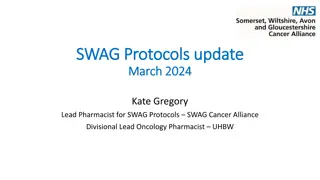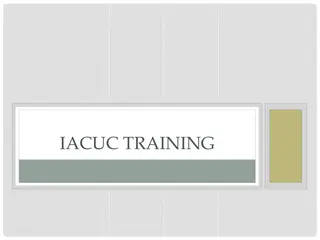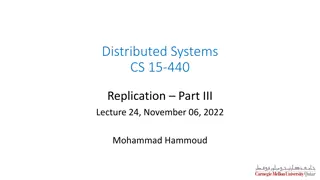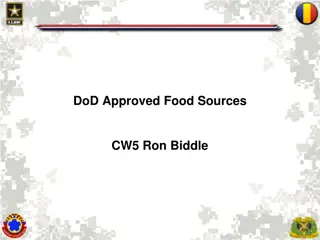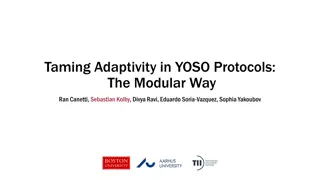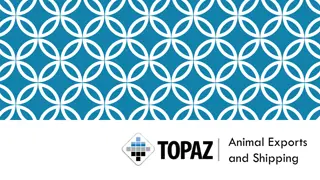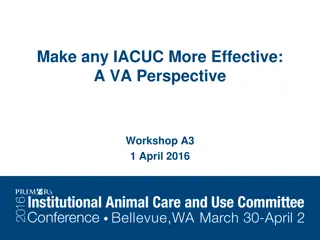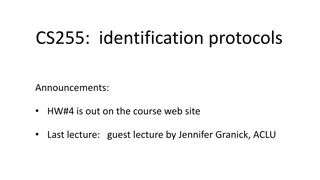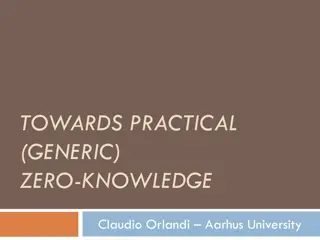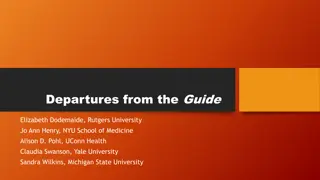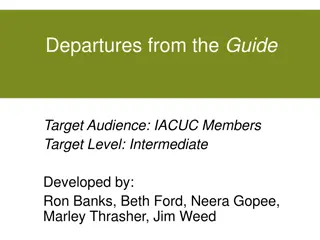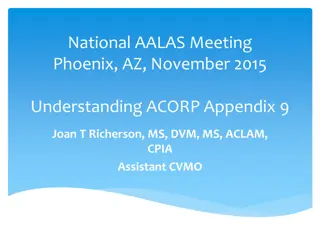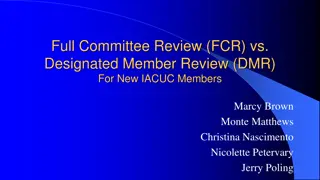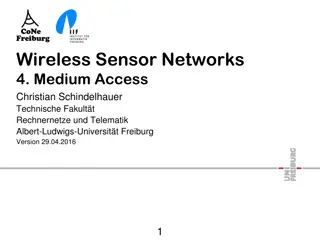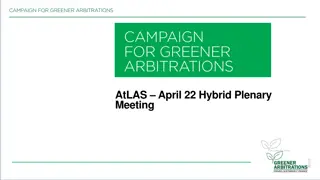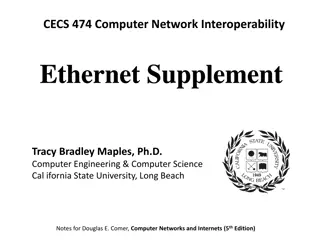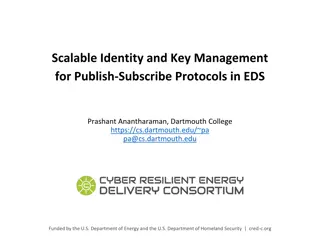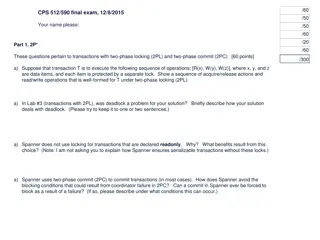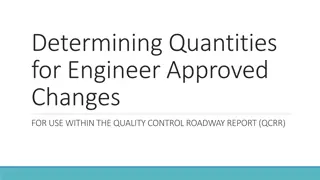Understanding Significant Changes in IACUC-Approved Protocols
This presentation covers essential information on significant changes in IACUC-approved protocols, including defining significant changes, reviewing methods, implementing the Veterinary Verification and Consultation process, and examples of significant changes. It also discusses the impact on animal welfare, regulatory documents, and common methods for reviewing changes.
Download Presentation

Please find below an Image/Link to download the presentation.
The content on the website is provided AS IS for your information and personal use only. It may not be sold, licensed, or shared on other websites without obtaining consent from the author. Download presentation by click this link. If you encounter any issues during the download, it is possible that the publisher has removed the file from their server.
E N D
Presentation Transcript
Significant Changes to Significant Changes to IACUC IACUC- -Approved Protocols Approved Protocols GROUP B GROUP B TIM ALLEN, MIKE ANDREWS, JAVIER CISNEROS, CLAIRE HANKENSON, RACHEL MURRAY
Goals This session will: o Provide IACUC members with a basic understanding as to what constitutes a significant change to an IACUC-approved protocol. o Allow IACUC members to gain an understanding of the review methods available to them for review and approval of significant changes. o Empower the IACUC to implement the Veterinary Verification and Consultation (VVC) process at their institution.
Objectives oDefine significant changes oDescribe the review methods for significant changes oFormulate a template process to implement Veterinary Verification and Consultation (VVC)
Think-Pair-Share What are some examples of significant changes? 1) Think to yourself what are some examples of a significant change (30 seconds). 2) Partner with your neighbor and discuss your ideas of significant changes (1 minute). 3) Share with the group some examples of significant changes (2 minutes).
What makes a protocol change significant? o Significant change: a change that has, or has the potential to have, a negative impact on animal welfare o Examples: Change from non-survival to survival surgery Change resulting in greater pain, distress, or degree of invasiveness Change in species Change in PI Changes in anesthesia, analgesia, sedation, or experimental substances Change in animal numbers
Background on Significant Changes o Two regulatory documents define the responsibilities of the IACUC regarding review and approval of proposed significant changes Public Health Service Policy on Humane Care and Use of Laboratory Animals IV.C.1 Animal Welfare Regulations 9 CFR 2.31 (d) (1) (i)-(iv) o Office of Laboratory Animal Welfare (OLAW) Notice (NOT-OD-14-126) provides guidance on significant changes to IACUC approved protocols IACUC discretion to use IACUC policies to define significant changes and the methods for reviewing and approving them USDA concurs with the OLAW guidance
Shout out What are the common methods of reviewing (any) changes?
Types of Review o Full Committee Review (FCR) A review method that may only be conducted at a convened meeting with a quorum of members present The quorum may vote to: approve, require modifications, or withhold approval DMR after FCR with IACUC Policy in place and all members in agreement o Designated Member Review (DMR) A review method in which at least one member of the IACUC qualified to review the item is assigned by the IACUC Chair to complete the review The entire IACUC must be given an appropriate amount of time to call for FCR Reviewers may only approve, require modifications, or request FCR
Types of Reviewcontinued o Administrative Review A review method by which administrative personnel may review and approve minor changes to protocols Examples: Typographical errors Correction of grammar Change in personnel, other than PI o Veterinary Verification and Consultation (VVC) A type of administrative review by which a qualified and authorized Veterinarian may review and approve a significant change to an IACUC- approved protocol
VVC Background o In March 2014, NIH put out a Request for Information (RFI) on proposed guidance regarding significant changes o As a result of feedback from the research community, VVC was proposed to assist with reducing regulatory burden (e.g. faster approval time) o NIH/OLAW revamped its proposed guidance to include the use of Veterinary Verification and Consultation for defined circumstances Allowed changes include: Changes in anesthesia, analgesia, sedation, or experimental substances Changes to euthanasia to any method approved by AVMA Guidelines on Euthanasia Changes in the duration, frequency, type, or number of procedures performed on an animal
Quick Poll Which of your institutions are currently using VVC for the review and approval of significant changes? If you are NOT currently using VVC, shout out a few reasons why it has not yet been implemented. What are some of the benefits of implementing VVC at your institution?
Veterinary Verification and Consultation (VVC) Process Flow for Proposed Significant Changes Does the request constitute a significant change topreviouslyapproved animal activities? YES NO Does the request include a change in any of the following: (a) anesthesia, analgesia, sedation, or experimental substances; (b) euthanasia method consistent with AVMA Guidelines; (c) duration, frequency, type, or number of procedures performed (d) increase in animal numbers Um not sure why you are using this flowchart? Proceed to happy hour . NO YES YES, but the requested changes may contribute to greater pain, distress, or invasiveness .then it may not be appropriate for VVC review Does your IACUC have a written policy/SOP/formulary that covers these significant changes? Changes will go through FCR or DMR process YES * NO Changes can go through VVC (a, b, c) with a(n) IACUC-designated veterinarian(s) or go through administrative review (d) An IACUC policy/SOP/formulary will need to be written before utilizing VVC *If veterinarian defers, return to IACUC for FCR or DMR
Join the Poll [Insert instructions for polling]
Scenario 1 A PI has methods of euthanasia on his IACUC-approved protocol that are approved by the AVMA Guidelines on Euthanasia. The PI wants to add isoflurane overdose as a primary method of euthanasia followed by decapitation as the secondary/confirmatory method in mice. Would VVC be an appropriate method to approve this change?
Scenario 2 A PI has a tail prick procedure to collect blood from mice approved on his protocol. The PI wants to increase the number of tail pricks to collect blood from four to eight collections. Would VVC be an appropriate review method? If this scenario involved tail snips instead of tail pricks, would VVC still be appropriate?
Scenario 3 The PI wants to add a class of treatment drugs to his protocol to study the effect of tumor growth. The protocol was approved for growing tumors in rabbits, but was not approved for the use of treatment drugs. Would VVC be an appropriate review method?
Things to Remember o Each institution handles the review and approval of significant changes differently. One is not necessarily better than the other. o You MUST have an IACUC reviewed-and-approved policy/SOP/formulary before you can implement any of these methods. o VVC is an optional tool available to the IACUC to review and approve significant changes to IACUC-approved protocols in order to reduce regulatory burden. The Veterinarian(s) MUST be designated by the IACUC to perform VVC.
LastlyVVC: Dont Be Scared Lastly VVC: Don t Be Scared- - Just Try It! Just Try It!
Summary of Goals and Objectives o Goals: Provide IACUC members with a basic understanding as to what constitutes a significant change to an IACUC-approved protocol. Allow IACUC members to gain an understanding of the review methods available to them for review and approval of significant changes. Empower the IACUC to implement the Veterinary Verification and Consultation (VVC) process at their institution. o Objectives: Define significant changes Describe the review methods for significant changes Formulate a template process to implement Veterinary Verification and Consultation (VVC)
Summative Assessment 1. Determine which of the following is considered a significant change (check all that apply): ____ Change in Funding Source ____ Change/Addition of Technical Personnel ____ Change in Euthanasia Method ____ Change in Species 2. List the possible types of review methods for reviewing and approving significant changes. 3. For each example listed below, indicate whether the VVC review process could be used: A. Changing the vitamin supplement to pigs from Flintstones to One-A-Day B. Addition of R/O blood collection to a protocol not previously approved for blood collection C. Change from a survival surgery to a non-survival surgery D. Change in PI 4. Create an action plan to implement VVC at your institution.



